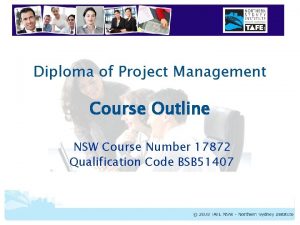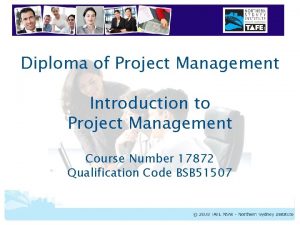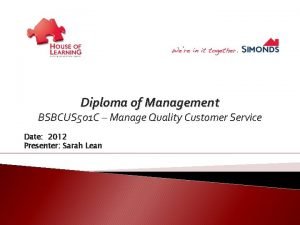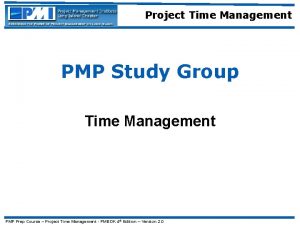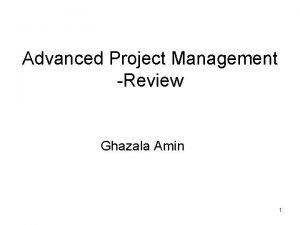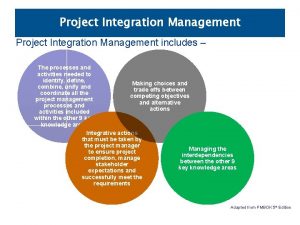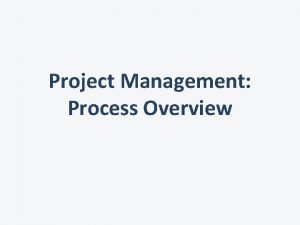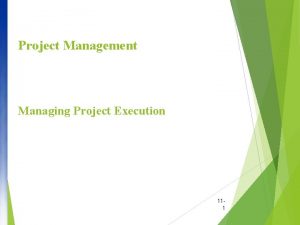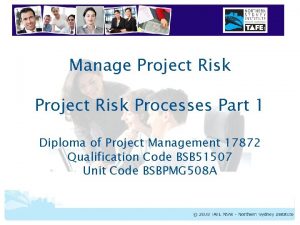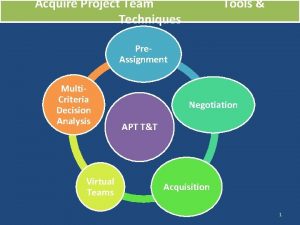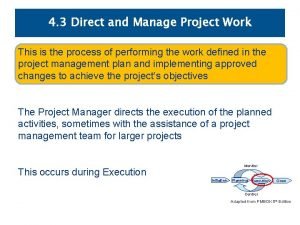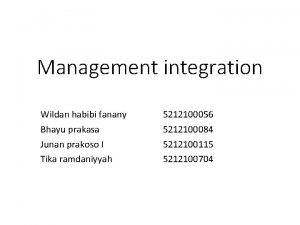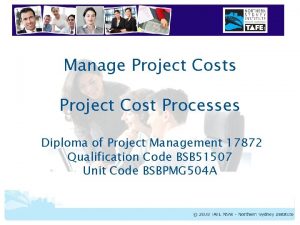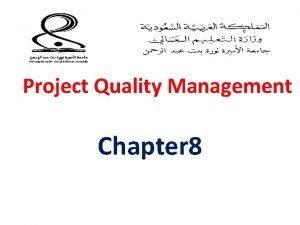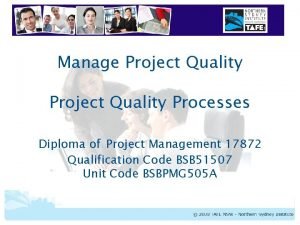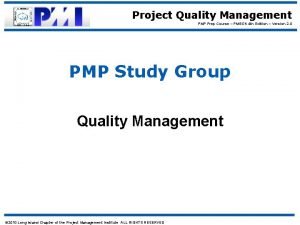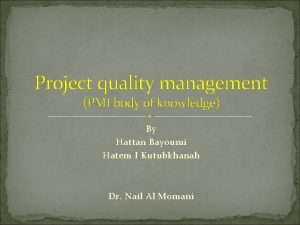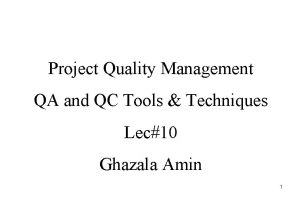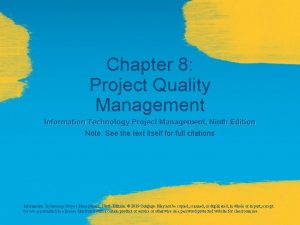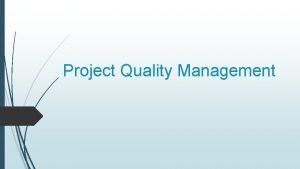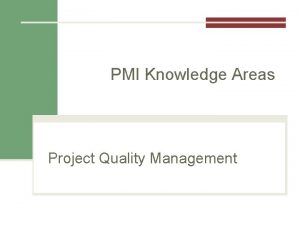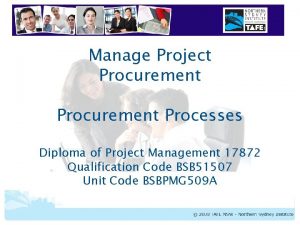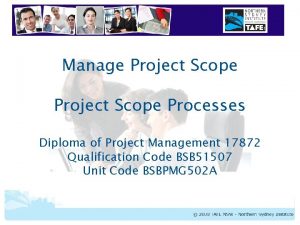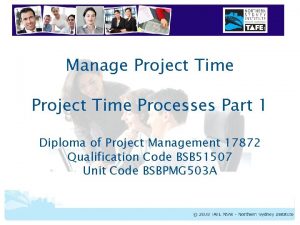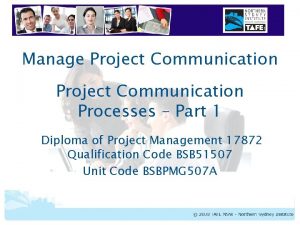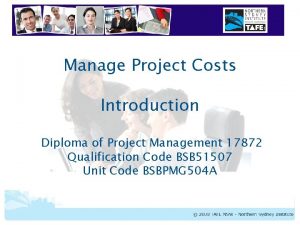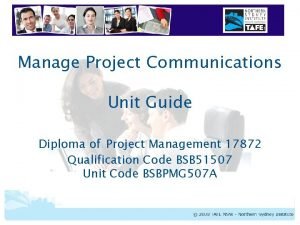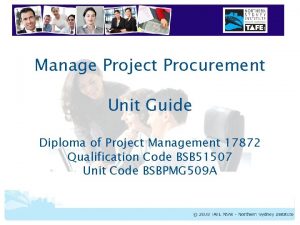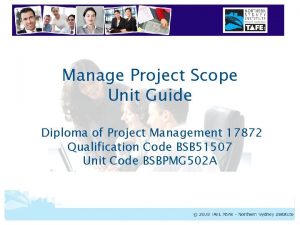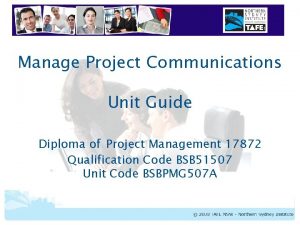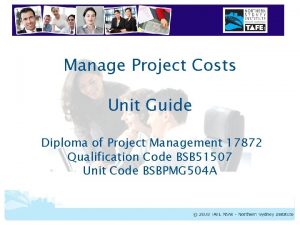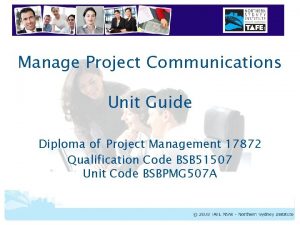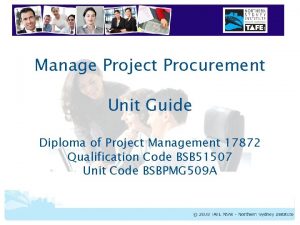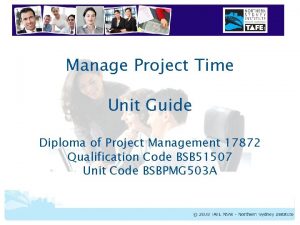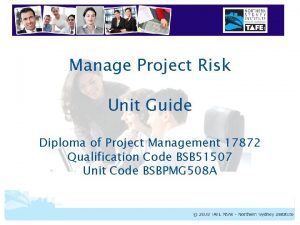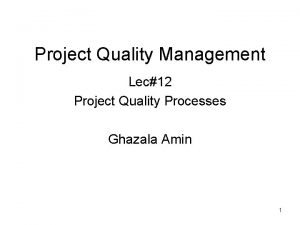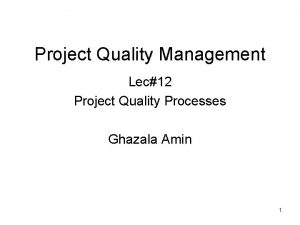Manage Project Quality Processes Diploma of Project Management






























- Slides: 30

Manage Project Quality Processes Diploma of Project Management 17872 Qualification Code BSB 51507 Unit Code BSBPMG 505 A Manage Project Quality

Manage Project Quality INTRODUCTION BSBPMG 505 A Manage Project Quality

What Is Quality? • The International Organization for Standardization (ISO) defines quality as ‘the degree to which a set of inherent characteristics fulfils requirements’ (ISO 9000: 2000). • Quality can also be based on conformance to requirements and fitness for use. • Conformance to requirements - The project’s processes and products meet written specifications. • Fitness for use - A product can be used as intended in the design BSBPMG 505 A Manage Project Quality 3

Conformance vs Fitness Example • Many people fail to understand the difference between ‘Conformance to Requirements’ and ‘Fitness for Use’, here is an example… • I need to buy a new car that can safely get me from Sydney to the Gold Coast. If this is my only requirement then I can buy any car on the market, and it would make sense to buy the cheapest possible car, as it would be meet ‘Fitness for Use’ criteria. • Why then, do I wait to buy the new Subaru Outback V 6 turbo diesel? • It is probably due to the fact that I had other non stated requirements such as wanting an All Wheel Drive; a brand preference for Subaru; and a high safety expectation. • Buying the cheapest car would have met the ‘Fitness for Use’ criteria, but buying the Subaru meets my ‘Conformance to Requirements’ criteria. BSBPMG 505 A Manage Project Quality

What Is Project Quality Management? • Project quality management ensures that the project outcomes will satisfy the needs for which the project was undertaken • It is critical to plan for quality outcomes. • Quality planning involves identifying which quality standards are relevant to the project, product and deliverables and how these will be – ü Included in the design and build processes – Quality Assurance ü Checked for conformance on completion – Quality Control BSBPMG 505 A Manage Project Quality 5

What Is Project Quality Management? • Project quality management addresses the quality requirements of the overall project and any products or deliverables are produced • The quality measures and techniques used are unique to the characteristics of the product • Project quality management is compatible with many different types of quality management approaches such as Six Sigma, Total Quality Management and ISO (International Organisation for Standardisation) BSBPMG 505 A Manage Project Quality

Basic Principles of Quality Management • Quality management complements project management, both disciplines recognise the importance of – ü Customer satisfaction ü Prevention over inspection ü Continuous improvement • Customer satisfaction – defining requirements and managing expectations so that customer requirements are met • Prevention over inspection – quality should be built in to the processes used to produce product and deliverables as the cost of preventing defects is less than the cost of fixing them at the end • Continuous improvement – learning from previous projects is built into future projects to ensure improvement, learnings can also be incorporated during project execution BSBPMG 505 A Manage Project Quality 7

Project Quality Responsibilities • Project Managers are ultimately responsible for quality management on their projects • Many large organisations have internal quality and risk management departments that should be able to assist with the identification of relevant standards and methodologies, as well as internal policies and procedures • Project Managers must seek out the quality standards relevant to – ü their industry, ü the project, and ü the product BSBPMG 505 A Manage Project Quality 8

The Importance of Quality Management • Failure to meet the quality requirements is a common reason for project failure and can have serious negative results • The quality of the end product of a project is critical, things can go drastically wrong if the end product does not meet the requirements ü People can die if machinery and medical equipment malfunctions ü People can loose their money if new banking systems don’t work correctly ü Space missions can fail if there are errors in project execution BSBPMG 505 A Manage Project Quality

Quality Management Terms for Projects Quality – ü the degree to which a set of inherent characteristics fulfill the requirements Cost of Quality – ü total cost of all efforts related to quality throughout the project or product development lifecycle Quality Audit – ü the process of examing the quality system or quality management plan, often carried out by an internal or external quality auditor or an audit team. A key element in the ISO quality system. BSBPMG 505 A Manage Project Quality

Quality Management Terms for Projects Quality Assurance – ü quality activities that are built in to the processes used to create the product and deliverables, can be performed by a manager, client, or even a third-party reviewer. E. g. reviews, process checklists and quality audits. Quality Control – ü quality activities performed at the completion of a product or deliverable, used to verify that deliverables meet the requirements and that they are complete and correct. E. g. inspection and testing. BSBPMG 505 A Manage Project Quality

Quality Assurance vs Quality Control • Quality control and quality assurance are important concepts, yet most project managers have only a vague understanding of the meanings and the differences between these terms. • Quality Assurance – ü Quality assurance activities are focused on the process used to create the deliverable. ü periodically evaluating overall project performance to ensure the project will satisfy the relevant quality standards. • Quality Control – ü Quality control activities are focused on the deliverable itself ü monitoring specific project results to ensure that they comply with the relevant quality standards BSBPMG 505 A Manage Project Quality

Quality Assurance vs Quality Control An important distinction – Quality Assurance Quality Control During Development On Completion Finding and correcting defects during quality assurance is much cheaper than finding and correcting defects during quality control BSBPMG 505 A Manage Project Quality

Quality Assurance vs Quality Control • Many people fail to understand the difference between ‘Quality Assurance’ and ‘Quality Control’, here is an example… • My husband recently started to do the grocery shopping and he very diligently follows the shopping list and tries as hard as possible to bring home everything on the list. • Unfortunately, sometimes when he gets home some of the produce doesn’t meet my requirements. The avocadoes are too hard and the strawberries are often mouldy. In this case the ‘Conformance to Requirements’ criteria has been met as he got everything on the list, but the ‘Fitness for Use’ criteria has not. • Other times he won’t have bought everything on the list as he couldn’t find it in his preferred supermarket. This can be a problem when I need mushrooms for the beef stroganoff that I wanted to make that night. In this case, neither ‘Conformance to Requirements’ nor ‘Fitness for Use’ criteria have been met. BSBPMG 505 A Manage Project Quality

Quality Assurance vs Quality Control • What Quality Assurance processes are evident in my husband’s grocery shopping process? ü I prepare a detailed list and he works from that list whilst he is shopping ü He checks the list during his shopping trip to ensure he has everything • What Quality Control processes are evident in my husband’s grocery shopping process? ü I check the quality of the produce when he returns home ü I check that he has bought everything on the list • What Improvements could be made to the process in order to increase Quality? ü He can have an alternate process if his preferred supermarket is out of something, then he can go to another supermarket for the additional items ü I can train him to select better produce BSBPMG 505 A Manage Project Quality

International Organisation for Standardisation • ISO (International Organization for Standardization) is the world's largest developer and publisher of International Standards. • ISO is a network of the national standards institutes of 161 countries, one member per country, with a Central Secretariat in Geneva, Switzerland, that coordinates the system. • ISO is a non-governmental organisation that forms a bridge between the public and private sectors. Many of its member institutes are part of the governmental structure of their countries, or are mandated by their government. Other members have their roots uniquely in the private sector, having been set up by national partnerships of industry associations. BSBPMG 505 A Manage Project Quality

ISO Quality Standards • ISO 9000 is a quality system standard that ü is a three-part, continuous cycle of planning, controlling, and documenting quality in an organization. ü provides minimum requirements needed for an organization to meet its quality certification standards. ü helps organisations around the world reduce costs and improve customer satisfaction. • The most commonly implemented family of quality standards is ISO 9001: 2008 - Quality management systems – Requirements BSBPMG 505 A Manage Project Quality 17

Standards Australia • Standards Australia is the nation’s peak non-government Standards organisation. It is charged by the Commonwealth Government to meet Australia’s need for contemporary, internationally aligned Standards and related services. • The work of Standards Australia enhances the nation’s economic efficiency, international competitiveness and contributes to community demand for a safe and sustainable environment. • It leads and promotes a respected and unbiased Standards development process ensuring all competing interests are heard, their points of view considered and consensus reached. • Standards are printed by their publishing company SAI Global, where you can purchase any ISO, AS (Australian Standard) or IEC (International Electrotechnical Commission) standards. BSBPMG 505 A Manage Project Quality

Common Quality Standards • There are many common quality standards available that cover different industries ü AS ISO 10006: 2003 – Quality management system – guidelines for quality management in projects ü BCA 2008 and BCA 2009 - Building Codes of Australia ü ISO 22000 - Food Safety ü AS/NZS 4801: 2001 - Occupational health and safety management ü ISO 14000/ 14001 - Environmental Management Standard ü ISO/IEC 15504 - Software Process Improvement and Capability d. Etermination (SPICE) ü ISO/IEC 25000: 2005 - Software product Quality Requirements and Evaluation (SQua. RE) BSBPMG 505 A Manage Project Quality 19

Different Quality Tools and Techniques • There are many different quality tools and techniques, the selection of these is determined by – ü the type of product being delivered by the project, ü organisational policies and procedures, and ü selected external standards Quality Standards Inspection Control Charts Cost of Quality Statistical Sampling Design of Experiments Pareto Chart Histograms Quality Management Methodologies Cost-Benefit Benchmarking Cause & Flowcharting Effect Diagrams Analysis BSBPMG 505 A Manage Project Quality Run Chart Failure Mode (FMEA)

Quality Management Methodologies Six Sigma – ü mathematically based process improvement approach focusing on customer satisfaction and defect reduction, used first at Motorola and used extensively at GE Corporation Total Quality Management (TQM) – ü management strategy that embeds awareness of quality in all organisational processes. TQM has been widely used in manufacturing, as well as NASA space and science programs Other Proprietary Methodologies – ü Lean Six Sigma, Quality Function Deployment, Deming, Juran, Cosby etc ü Can be selected by your organisation for quality management purposes BSBPMG 505 A Manage Project Quality

Deming’s Quality Equation Results of Work Efforts Quality = Total Costs Increased Quality Focus on Quality Decreased Costs Decreased Quality Focus on Cost Increased Costs BSBPMG 505 A Manage Project Quality

Quality Tools and Techniques Benchmarking – ü generates ideas for quality improvements by comparing specific project practices or product characteristics to those of other projects or products within or outside the performing organisation, relates to lesson learnt Cost Benefit Analysis – ü Primary benefits of meeting quality requirements are less rework, higher productivity, lower costs and increased stakeholder satisfaction. Compares the cost of the quality activity with the benefits. Flowcharting and Process Analysis– ü Graphical representation of a process that helps to identify potential quality problems. Examination of process efficiency and failures BSBPMG 505 A Manage Project Quality

Quality Tools and Techniques Cost of Quality – ü Totals all costs incurred in quality assurance and quality control activities over the life of the project, product or deliverable. Includes cost of rework and defect rectification. Cost of Conformance Prevention Costs • Training • Documented processes • Equipment • Time to do it right Appraisal Costs • Testing • Destructive testing losses • Inspections BSBPMG 505 A Manage Project Quality Cost of Non Conformance Internal Failure Costs • Rework • Scrap or waste External Failure Costs • Liabilities • Repairs under warranty • Lost business

Quality Tools and Techniques Control Charts – ü Statistical method used to determine if a project or production process is stable and has predictable performance. The upper and lower limits relate to the requirements. Statistical Sampling – ü Examines a selection or sample group of outputs, products or deliverables for conformity to the requirements and quality standards Design of Experiment ü Statistical method for identifying the factors that have the most influence over the quality of the end product, determines the accuracy of testing activities BSBPMG 505 A Manage Project Quality

Quality Tools and Techniques Inspection – ü Examination of a deliverable or product to determine if it meets the documented quality standards and requirements Cause and Effect Diagrams – ü Ishikawa or fishbone diagrams. Illustrate the linkages between quality problems and their potential causes Failure Mode Effects Analysis – ü More comprehensive that Cause and Effect Diagrams, involves determining ALL potential failures, the impacts of the failures and actions to both manage and prevent failures BSBPMG 505 A Manage Project Quality

Quality Tools and Techniques Histograms – ü Bar chart used to document the frequency with which certain events (defects or failures) occur Pareto Charts or Pareto Diagrams – ü Type of histogram that is ordered by frequency of occurrence. It shows the defects generated by the categories of the identified causes Run Chart ü Similar to a control chart but doesn’t display the upper and lower performance limits, shows total variation in a process over time to enable trend analysis BSBPMG 505 A Manage Project Quality

Meeting Quality Outcomes To meet the quality requirements, Project Managers must – ü Ensure that detailed requirements and specifications are documented and agreed with stakeholders ü Understand the relevant quality standards for their industry and product ü Understand follow organisational quality methodologies, policies and procedures ü Plan for quality assurance and quality control activities in detail ü Detail the impacts of change requests on quality requirements and processes ü Ensure that defects are repaired and monitored BSBPMG 505 A Manage Project Quality

Quality Assurance vs Quality Control 1. Consider the differences between Quality Assurance and Quality Control. 2. Come up with an example of a common process and prepare a detailed description of how quality assurance is built into the process and how quality control occurs at the end of the process. 3. Ensure that you have thought about all the different types of tools and techniques that could be used and include these details in your submission. 4. Then go to Forums – Quality Assurance versus Quality Control and discuss your findings. Practice BSBPMG 505 A Manage Project Quality Learn Improve

Next Steps Please proceed to Quality Processes in the Learning Program. Best of Luck! BSBPMG 505 A Manage Project Quality
 Bsb51407
Bsb51407 Dual diploma project management
Dual diploma project management Bsbcus501 manage quality customer service
Bsbcus501 manage quality customer service Concurrent processes are processes that
Concurrent processes are processes that Project time management definition
Project time management definition Project management processes
Project management processes Integration management in project management
Integration management in project management Six processes of project integration management
Six processes of project integration management Sub processes of project management
Sub processes of project management Direct and manage project execution
Direct and manage project execution Bsbpmg508a manage project risk
Bsbpmg508a manage project risk Project team assignments
Project team assignments Direct and manage project work
Direct and manage project work Direct and manage project work
Direct and manage project work Money management international
Money management international Project costing diploma
Project costing diploma American diploma project
American diploma project Introduction to software project management
Introduction to software project management Pmbok quality assurance vs quality control
Pmbok quality assurance vs quality control Project quality management definition
Project quality management definition Perform quality control
Perform quality control Project quality management lecture notes
Project quality management lecture notes Perform quality control
Perform quality control Control chart precision accuracy pmp
Control chart precision accuracy pmp Quality control tools and techniques
Quality control tools and techniques Plan quality management pmp
Plan quality management pmp Project management quality control
Project management quality control Project management quality control
Project management quality control Plan quality management tools and techniques
Plan quality management tools and techniques Importance of project quality management
Importance of project quality management Quality management in operations management
Quality management in operations management
